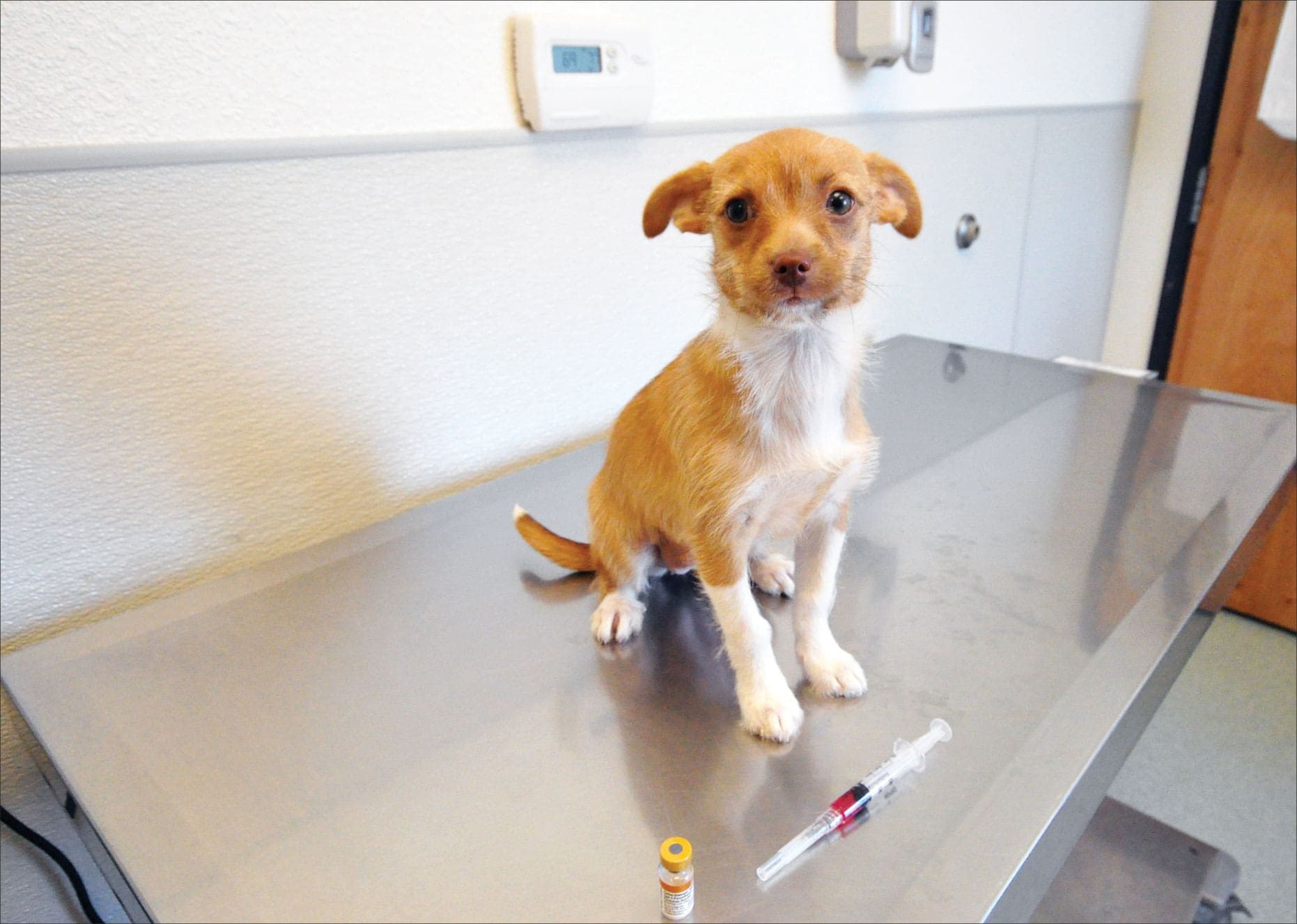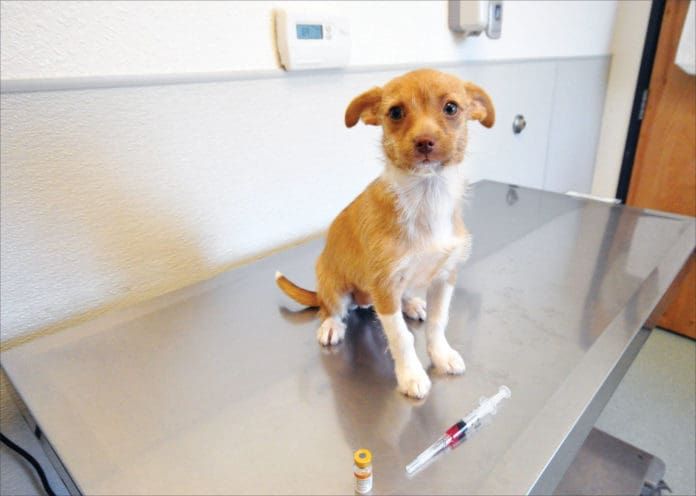It’s always been interesting to me that few people know why young puppies have to be vaccinated several times, a few weeks apart – and yet, few question the practice. There’s a term for it: puppy shots! The concept is widely accepted – and rarely explained. In my experience, when people ask why a puppy needs repeated vaccinations, they are told something vague and inaccurate, such as, “It takes a few shots to build the puppy’s immunity.”

It’s a similar situation with annual or semi-annual so-called vaccine “boosters” – not many people know much about their dogs’ vaccination status, so they take their veterinarians’ word that their dogs are “due” for more vaccinations.
The truth is, there is no single vaccination protocol that will protect all dogs for all things, without over-vaccinating most of them. Vaccination really ought to be determined on a case-by-case basis, because each dog’s risk factors are unique, based on his age, genetic inheritance, current health, geographic location, and lifestyle.
That said, there is a very useful tool that can help an owner gain solid information about whether her dog is likely to be protected against the most common infectious diseases: the vaccine titer test. Positive test results can also give a dog owner some solid ammunition for countering those who blindly promote (or require, in the case of some boarding or training facilities) so-called “current” vaccinations, which can mean many different things to different people.
Core Canine Vaccines
The closest thing that there is to a universal list of recommendations for canine vaccinations in North America is produced by the American Animal Hospital Association (AAHA). The veterinary medical experts who have contributed to the AAHA’s recommendations agree that there are a handful of infectious diseases that pose a threat to all dogs and that all dogs should receive vaccinations for those diseases; these are commonly referred to as the “core” vaccines.
Core vaccines include:
Canine distemper virus (CDV, commonly referred to as distemper)
Canine parvovirus (CPV, parvo)
Canine adenovirus (CAV, better known as canine hepatitis)
Rabies
Among healthy dogs, the first three “core” vaccines are expected to induce a protective immune response lasting at least five years. However, much longer protection from these vaccines has been demonstrated in dogs in many studies – sometimes, even as long as the dogs’ lifetime.
Rabies is a slightly different case. Because the disease poses a significant risk to human beings, it’s the only vaccine that is required by law to be administered to dogs. Each state has its own legal requirements for rabies vaccination. Some require annual rabies vaccinations; the rest require the vaccination be given every two or three years (depending on the state). There is ample evidence that rabies vaccines confer protection from rabies for longer than three years, but given the public health risk to humans, there is considerable pushback from public health officials to the idea of extending the legal requirement for rabies vaccines.
Noncore Vaccines
There are also a number of vaccines for infectious diseases that can pose a risk to some dogs, depending on individual risk factors and geographic location. These are called the “noncore” vaccines, and they include:
Bordetella bronchiseptica (Bb, kennel cough)
Borrelia burgdorferi (Lyme disease)
Canine coronavirus
Canine parainfluenza virus (CPiV, parainfluenza)
Leptospira spp. (leptospirosis)
Measles virus
Most of these vaccines are useful in certain circumstances, but the evidence falls short of proving that they are helpful to all dogs everywhere. Further, there is proof that some of the noncore vaccines can be harmful to certain dogs. For these reasons, the AAHA recommends that the administration of these vaccines should be decided on an individual basis by a veterinarian familiar with the puppy or dog and the local risks.
As just one example, Lyme disease is prevalent in some parts of the country, and quite rare in others, and it is transmitted by tick bites. Also, some dogs can suffer serious side effects from the vaccine. So if a dog lives in a part of the country where Lyme is not common, and/or if you have a dog who has very little exposure to environments where ticks are likely, the risks of vaccinating that dog for Lyme outweigh the potential benefit.
A Test of Protection
Let’s go back to the diseases that every dog should be protected from; these are the ones that are most likely to appear on the reminder postcards sent out by your veterinarian – and the ones that you will experience the most pressure (from your veterinarian’s staff) to repeat in order to keep “current.” Depending on your vet, “current” may be defined as annually, every three years, every five years, or longer. As little as 20 years ago, it was widely thought that annual vaccinations “couldn’t hurt, and might help,” and most veterinary practitioners recommended that their clients vaccinate every dog annually. But today, we understand that canine vaccines don’t “wear off” or “become due” in any standard amount of time. Also, it’s better understood today that randomly stimulating the immune system can have negative consequences that we don’t fully understand, so we should be more discriminating about vaccinations.
Let’s put a fine point on it: The core vaccines are an important and life-saving component of responsible dog care when administered properly – neither too frequently nor inadequately. Which brings us back to the original question: How do you know when your dog is protected – or unprotected – against the core diseases?
The best tool at our disposal today is something called a vaccine titer test, and in our opinion, every dog should be tested at least once, and again every three years or so.
When we vaccinate a dog, we administer disease antigens (in a weakened, modified, or killed form that can’t cause disease) in order to stimulate the dog’s immune system to produce antibodies, molecules that are produced to recognize and neutralize that specific antigen, should they ever cross paths. A vaccine titer test checks for and quantifies the amount of antibodies to specific diseases that a dog has circulating in his blood.
The technology exists to detect any specific antibody for which we may have vaccinated a dog; we can test whether a dog possesses circulating antibodies for any disease. But as it turns out, that’s not necessary.
There are two types of antibodies that are highly predictive of the competence of a dog’s overall immune response to vaccines: distemper and parvo. If a dog has been vaccinated against distemper and parvo, and develops antibodies to these diseases, the odds are very good that he has developed antibodies for any other core disease for which he has been vaccinated.
In other words, a positive vaccine titer test for parvo and distemper can put your mind at ease – and should put your veterinarian’s mind at ease – that your dog is adequately immunized against the core disease vaccinations he has received.
The AAHA – and vaccine-savvy veterinarians – recommend that puppies receive a vaccine titer test about two weeks after they have been given their final puppy core vaccinations (which should occur when the puppy is about 14 to 16 weeks old). Again, a positive result for both distemper and parvo antibodies indicates that the puppy is properly immunized. The AAHA’s recommendation is that adult dogs are tested about every three years, to ensure that they still possess circulating antibodies for the core diseases.
Negative Results
What about when vaccine titer tests come back negative for distemper and/or parvo antibodies? The significance of this result depends on a few factors, including the dog’s age and vaccination status, and the vaccine used.
If the test was for a puppy who recently completed a series of core vaccines, he should be revaccinated promptly, and then a titer test run again about three weeks later. The most likely explanation is that something called “maternally derived antibodies” (MDA,antibodies he received via colostrum from his mother) were still active in his bloodstream when the vaccines were given, and they neutralized the antigens present in the vaccines.
Maternal antibodies don’t last forever, however; they “fade” at an unpredictable rate. The maternal antibodies can fade quickly (or may be absent) if a pup’s mother was unvaccinated, or he received very little or no colostrum from his mother. If his mother had an unusually high antibody titer herself (the highest levels result from surviving an infection with the disease itself), her pups’ MDAs might take longer than usual to fade. This would render all of the puppy’s early vaccinations useless; only vaccinations given after the MDA faded would stimulate the puppy’s own antibody production.
However, if the puppy was undoubtedly more than 20 weeks old when he was vaccinated the final time, and his vaccine antibody titer test results (from a sample taken three weeks after the last vaccination) were still negative, it could indicate that he was a “non-responder” – a dog who could not be properly immunized.
It’s been estimated that 1 in 1,000 dogs are not able to respond to the canine parvovirus vaccine; those dogs will be at a lifetime risk of contracting the disease (though the risk if greater when they are puppies; adults are more likely to pull through with prompt and dedicated care). Far more rare are dogs who cannot respond properly to the distemper vaccine antigen; this is estimated to occur in about 1 in 10,000 dogs.
The third possibility for the dog’s failure to produce antibodies in response to vaccination: bad or improperly stored vaccine. In this case, a different vaccine should be used, and the dog re-tested a few weeks later. According to the AAHA guidelines, “If, after one or more attempts at revaccination with a product different than the one originally used, the dog fails to develop an antibody response” to distemper or parvo vaccines, the dog should be considered a nonresponder.
Canine vaccine experts agree that if a dog previously had a positive antibody titer for both distemper and parvo, and upon later titer testing is negative for one or both antibodies, he should be revaccinated with the core vaccines, and another titer test should be ordered about three weeks later.
There are people who disagree, however. The antibodies may no longer be in circulation, but if they had been present earlier in the dog’s life, the dog should have immune memory cells – that we can’t detect with lab tests – which should, if a dog is exposed to the disease antigen, recognize the antigen and re-start production of the appropriate antibodies.
It’s a valid theory . . . but the most-respected small-animal vaccine expert in the country, Ronald D. Schultz, PhD, of the University of Wisconsin-Madison, disavows the wisdom of the practice. Dr. Schultz has studied animal vaccines for decades, and as a consultant and researcher, has helped develop many of the ones on the market. “You have to consider a dog who has no detectable antibodies against disease to be unprotected for that disease,” he says firmly. “I would revaccinate the dog. The risks of contracting the disease are far greater than the risk posed by vaccines – particularly in a very infrequently vaccinated animal.”
Titer Caveats
I can tell you from personal experience that it can be difficult to be the first in your veterinarian’s practice to ask for a vaccine titer test in lieu of automatic revaccinating. The staff may not understand which test to order; a practice manager once told me it would cost $50 – $100 for a test of each vaccine in the combination shot the vet wanted to give my dog Otto. I actually helped them find and order the appropriate test from their laboratory catalog, but switched veterinarians shortly afterward.
During my second visit to the next veterinary clinic I tried, one of the practice owners spent 20 minutes arguing with me about the value of titer tests. “There is no way to know what titer numbers are protective,” she stated, and added that “even dogs with positive titers can contract disease.”
Those statements are both technically true – but it’s very, very rare for a dog who has any circulating antibodies to a disease to become infected with that disease upon exposure. Practitioners who make statements like this are unlikely to add the corollary to this – that dogs who do not have detectable antibodies to a specific disease may be able to fend off a challenge (exposure) to that disease, again, thanks to as-yet immeasurable “cell-mediated immunity.”
I want a collaborative professional relationship with my dogs’ veterinarian. If we have very different opinions about something as basic as vaccination, the chances are we will butt heads over other treatments, too. I advise looking for a new doctor to work with if your vet is resistant to running a titer test in lieu of needless and potentially harmful overvaccination. In my experience, veterinarians who are either under 40 or interested in holistic medicine (or both) will readily and with professional curiosity order a titer test for your dog.
The veterinary medical laboratories that provide vaccine titer tests all offer a combined canine distemper/parvo vaccine titer test that is less than the cost of running two separate tests. The price you pay will vary, depending on which lab your vet uses and how much your vet charges for taking a blood sample for your dog and sending it to a lab; your veterinarian may also mark up the cost of the test.
The labs founded by veterinary vaccine experts Jean Dodds, DVM (Hemopet) and Ronald Schultz, PhD (CAVIDS Titer Testing Laboratory at the University of Wisconsin-Madison) charge a flat fee for the tests, but you still have to pay your veterinarian for taking and shipping the blood sample. The CAVIDS Titer Testing Laboratory has the lowest-cost test of $40; this price is partially underwritten by Maddie’s Fund, as the samples submitted become part of ongoing studies in vaccine research.
The large national labs charge different prices depending on the size of the local market and the volume of tests (all the lab tests, not just titers) ordered by your individual veterinarian.
Some vets now offer in-office vaccine titer tests, such as the Synbiotics TiterCHEK® CDV/CPV test. This can be run while you and your dog are in the clinic for an examination, making it possible for you to follow up on the spot with a vaccination if your dog has a negative result. Again, the price charged by your own veterinarian will vary for these tests.
Antech Diagnostics: $75 – $150
Irvine, CA
Hemopet: $52
Garden Grove, CA
Idexx Laboratories: $75 – $150
Westbrook, ME
CAVIDS Titer Testing Laboratory: $40
Madison, WI
A Tale of Two Shelter Dogs and Vaccination
I adopted my mixed-breed dog Otto from a local shelter in June 2008. He was estimated to be about 7 months old and had been turned into the shelter in early May, about six weeks before I adopted him. At the time I adopted him, he had been vaccinated five times already, with four combination vaccines and once for rabies.
Given his estimated age when I adopted him – at least 6 or 7 months old – I felt confident that no maternally derived antibody would interfere with any of those vaccines, and that Otto was more than adequately immunized. (In fact, it’s likely that he was overvaccinated, a practice that is typical in shelters.) Had he been younger, so that maternally derived antibodies could have nullified his vaccinations, I probably would have ordered a vaccine titer test at the time of adoption, to confirm his immunization status.
In May 2009, Otto was due for and received a (legally required) rabies vaccination. Standard practice calls for the use of a one-year vaccine when the dog is first vaccinated for rabies, and then vaccines that are approved for longer periods after that. In California, the longest period that a dog can legally go between rabies vaccinations is three years, so I asked for a three-year rabies vaccination at that time.
The veterinarian who saw Otto for that visit gently recommended another combination vaccine, but I demurred and this sufficed. However, the invoice I received for the visit indicated that Otto was “due” for a “DHLPP-C annual vaccine” and a “Bordetella annual vaccine” the following month – a year after his last combination vaccine. No one seemed very concerned about the vaccinations at this time, least of all me.
In April 2010, I made an appointment with the veterinarian who had seen Otto the previous spring; I needed to get a new prescription for heartworm preventatives for Otto. At this appointment, the vet (a gentleman who is probably in his late 60s or early 70s) pressed hard for Otto to receive another combination vaccine. We bantered a bit about vaccination schedules and overvaccination. I finally asked if he’d feel better if we had a titer test result that showed Otto still had circulating antibodies to parvovirus and distemper. He said he would, so I had him take a blood sample and send it off to IDEXX Laboratories. (Despite his age, this was probably a first for his clinic. The office manager first quoted me $500 for the titer test. When I insisted that was too much, she admitted that she was looking at a price book for the lab and wasn’t certain which of the tests she was supposed to order. I helped her locate the code for the correct test, which IDEXX called the “Vaccination Profile Canine (ELISA),” and paid $100 for the test.
I have ordered annual vaccine titer tests for Otto ever since, and every one has come back with strong positive results. He was vaccinated with another three-year rabies vaccine in 2012, and is next required by law in early 2015. I have no plans to vaccinate him for anything else unless one of his titers comes back negative.
In January of this year, my son adopted a puppy from the same shelter. Cole’s estimated age was 12 weeks. He had been vaccinated with a combination vaccine four times since he arrived at the shelter.
I brought him to see my veterinarian at the estimated age of 18 weeks for a titer test. The result came back positive for parvo, but negative for distemper! Oh no! Did we inadvertently adopt a non-responder, who would be at risk for distemper throughout his lifetime?
I had ordered the test from Dr. Shultz’s lab, and the results take a little longer than from the big commercial outfits, so it was two weeks before I took Cole back to the vet to discuss the results. We agreed we should revaccinate with a different product, and then run another titer test. During this consultation, the vet examined Cole thoroughly, and suddenly was struck by Cole’s teeth. “I don’t think he’s 20 weeks old,” she said. “I bet he’s more like 16 weeks today.” We surmised that “maternal interference” was to blame for his negative titer for distemper antibodies.
We revaccinated Cole and ran another titer two weeks later. This time, the results were a nice high positive. Whew! I can rest now, knowing he’s protected.
Nancy Kerns is the editor of Whole Dog Journal.







I just requested a titer test today for distemper and parvo for my two dogs. Just the distemper titer was quoted at $120. I looked up the vaccicheck website and they sent me a list of vets in my area that use their titer, and the average was $150 for that titer! I feel like that is expensive! I have tried to look up Dr. Schulz website from your link, and am having trouble. I think the link is different. If I use his service, about how much should I expect the vet to charge me for drawing blood and sending off the sample? This seems so much harder than it should be! So aggravating!
absolutely agree!!!!!!!!!!!!